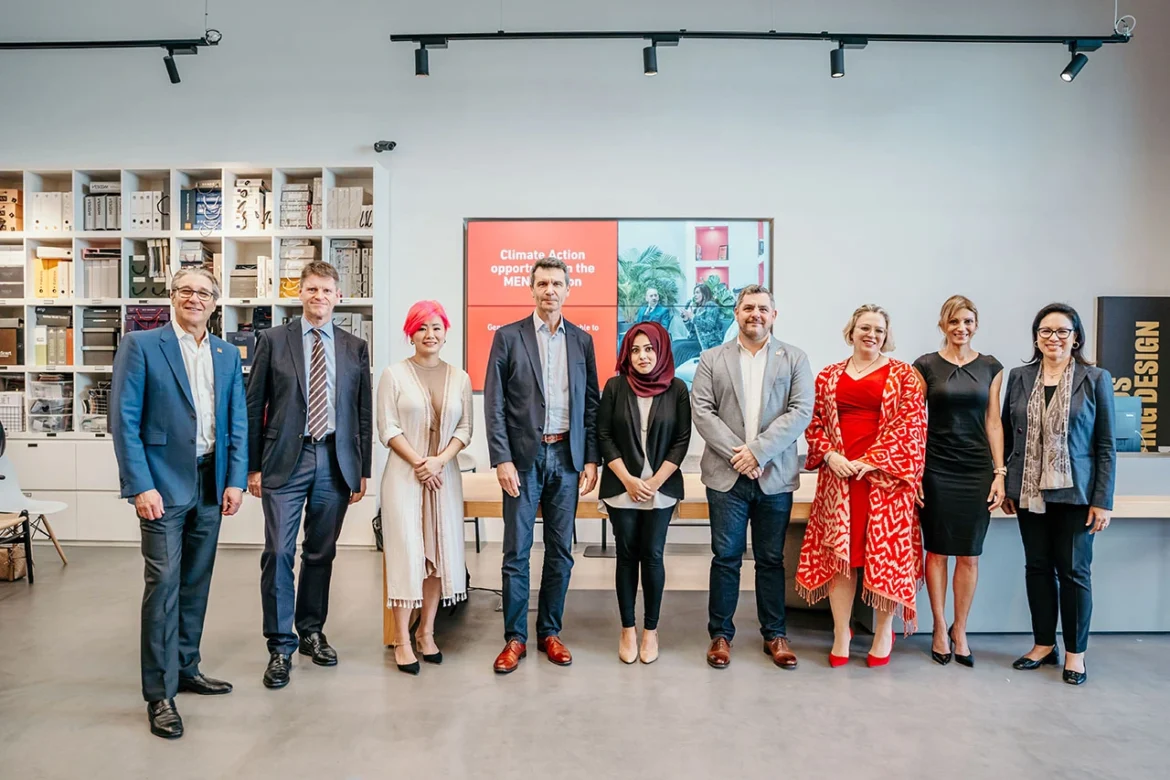Gensler, the world’s largest design firm and leader of sustainability in the built environment, hosted the panel in-line with COP28’s built environment agenda. The event was the finale in a series of industry panels in the leadup to the climate conference and focused on the importance of collaboration in the built environment to drive change and achieve the Sustainable Development Goals (SDGs).
The panel was moderated by Juliette Morgan, ESG Consultancy Director at Gensler. She was joined by experts from across the industry, representing all elements of the built environment: Adora Li – Managing Partner, Bightkey Partners; Ana Hudson – Head of Sustainability, Saudi Entertainment Ventures (SEVEN); Paul Dunne – Director, Middle East, ARUP; Paul King – CEO, Built by Nature; and Sakina Hassanali – Head of Development Consulting and Research, HassConsult Real Estate.
Gensler’s Co-CEOs Diane Hoskins and Andy Cohen joined their Middle East team in Dubai for COP28 and are leading the way on sustainable development in architecture and design. The Co-CEO’s opened the event: “The built environment represents 40% of global emissions. As an industry, we have a huge challenge, but also an amazing opportunity to change the world for the better. It will be the built environment that makes the difference on slowing down global warming so our industry needs to come together at a global level to make an impact.” Said Diane Hoskins.
Andy Cohen added: “It’s been amazing to attend COP this year and be a part of public and private sector leaders driving climate action. Climate action is the moral and business imperative of our time, and as the largest and leading design firm in the world, we have a responsibility to act, and act now. We are committed to being a catalyst for driving positive change, with all of Gensler’s projects reaching net-zero or carbon positive by 2030.”
A key takeout from Gensler’s event was the importance of collaboration and inclusivity across the sector. Juliette Morgan commented: “This COP is pivotal and is meeting at a point when the world is under multiple pressures – be that economic, nature or human-based. With global greenhouse gases projected to rise 9% by 2030, innovating our design and processes has never been more urgent. The challenge of our time is to drop Co2 emissions by 45% by 2030, to maintain a habitable planet, and to do so at a time when cities need to be built and refurbished.
“We have assembled a stellar panel this morning to debate topics from building with nature, to accelerating innovation. We are living through a period of transition, and the question of architecture’s role has now been posed. Our industry needs diverse voices and a collective effort to design the world into being.”
Key insights from the speakers included: Sakina Hassanali opened for the panellists and focused on what social considerations developers should keep in mind when adapting to rapid changes in design trends: “In a time of rapid change, we are seeing rising cases of anxiety, depression, isolation, lack of in-person social connections and loss of community.
“In a fast-paced world, the built environment can serve as an anchor for the population, if created with a purposeful connection with the outdoors, community integration and interior spaces that prioritize physical and mental well-being.”
Ana Hudson stressed the importance of the need for dramatic change in human behaviour in a short period: “Two fundamental components in designing for sustainability and decarbonization are enhancing building efficiency and promoting behavioral change. As a result, the architecture and design sector must focus on integrating strategies that encourage sustainable behaviors into our designs. This approach is critical for meeting the UN Sustainable Development Goals and achieving our decarbonization objectives. It’s a momentous challenge that needs to be addressed directly and quickly.”
Paul Dunne discussed the commitment that was needed to drive change: “We owe it to ourselves as designers to ask what we can do better. We must accelerate decarbonization progress by fully understanding the total impact of carbon in the built environment, gathering data to inform our design, and then collaborating to ensure every organisation is accountable. We need to be bold and challenge norms.”
Paul King shone a light on the progress that is being made: “With total carbon emission volumes ranking China first, then the US and third being concrete, I’m relieved to see our industry is stepping up its focus on climate action. The built environment only got a dedicated day at COP a few years ago, and is now under the spotlight. At this COP, we’ve seen the launch of the Buildings Breakthrough and the Forest and Climate Leader’s Partnership’s (FCLP) which will be pivotal in accelerating transformation in the buildings and construction sector.”
Adora Li took inspiration from nature and applied it to investing in climate action: “We need to treat financing and impact, not as a zero-sum game, but as an opportunity to build an ecosystem and to cross-pollinate. Architects have ideas that come from imagination and research. In finance, we don’t necessarily have those same tools, but if we truly collaborate, that cross-pollination suddenly turns into an abundance of opportunity.”
The panel concluded with a poignant quote from Juliette Morgan: “We live in an age that should be characterised by possibilism. Through interdisciplinary work and hearing diverse perspectives and opinions, we can design for the good of people and planet.”
Gensler continues to be at the forefront of promoting sustainable design practices and driving climate action, underlining its commitment to creating a future that prioritises equity, resilience, and well-being for all.
tanvir@dubainewsweek.com

